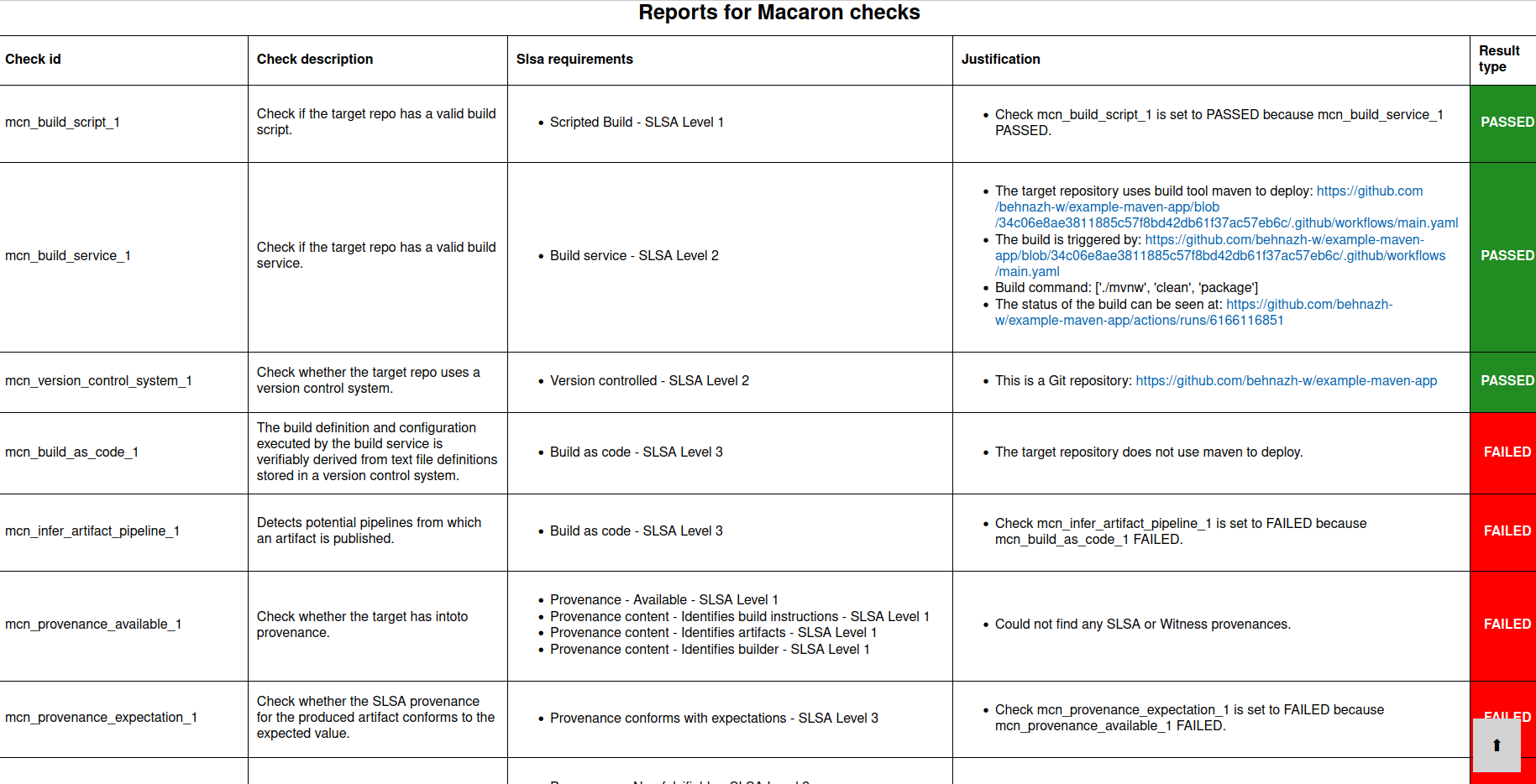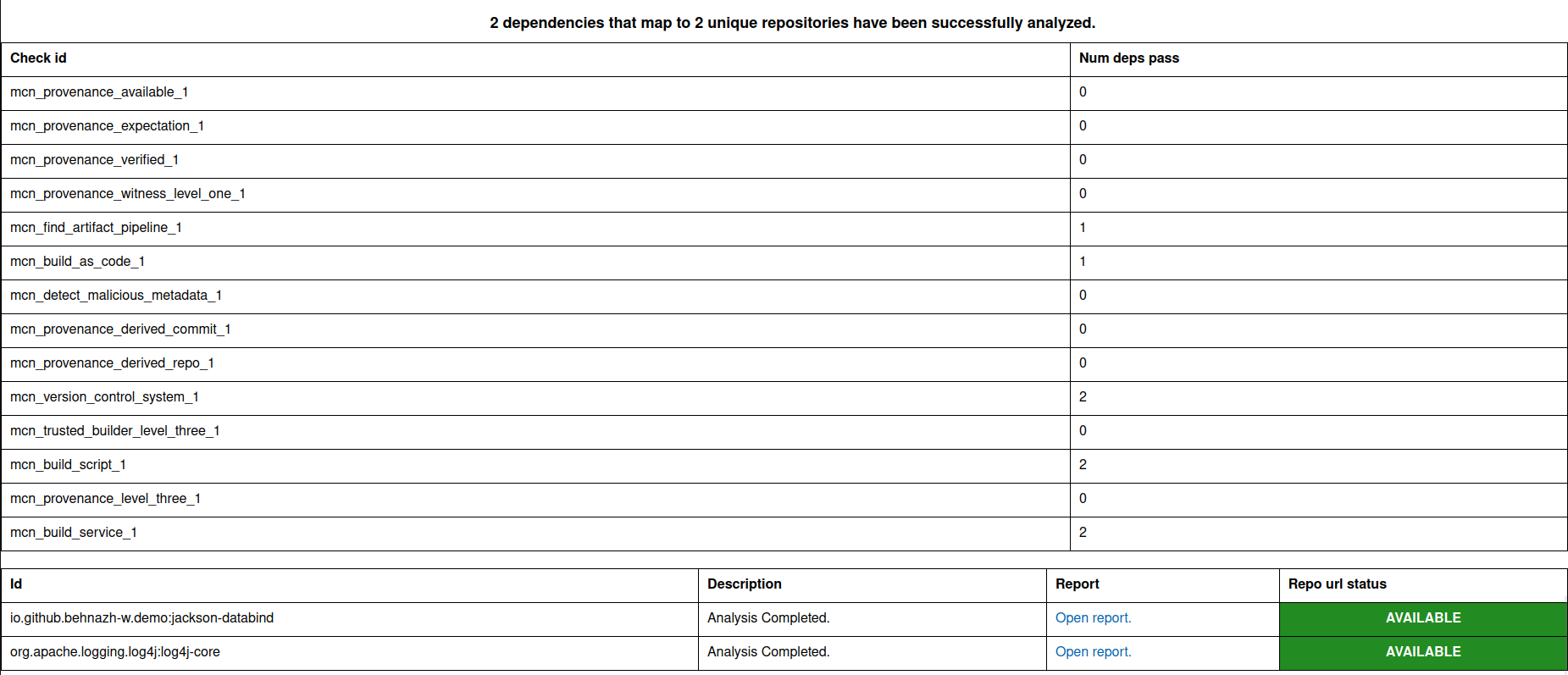Detecting Java dependencies manually uploaded to Maven Central
In this tutorial we show how Macaron can determine whether the dependencies of a Java project are built and published via transparent CI workflows or manually uploaded to Maven Central. You can also watch the demo of this tutorial.
When an artifact is manually uploaded, the artifact distributor can modify the artifact and potentially include malicious code without being detected. The example project we analyze in this tutorial is example-maven-app, which is hosted on GitHub. This example application uses Maven to build and manage dependencies, and has two dependencies:
Artifact name |
|
|---|---|
|
|
|
While the log4j-core dependency follows best practices to publish artifacts automatically with minimal human
intervention, jackson-databind is a malicious dependency that pretends to provide data-binding functionalities
like the official jackson-databind library (note that
this artifact is created for demonstration purposes and is not actually malicious).
Now let’s see how Macaron can help us with evaluating the supply chain security posture of
example-maven-app and its dependencies.
Installation and Prerequisites
Skip this section if you already know how to install Macaron.
Please follow the instructions here. In summary, you need:
Docker
the
run_macaron.shscript to run the Macaron image.
Note
At the moment, Docker alternatives (e.g. podman) are not supported.
You also need to provide Macaron with a GitHub token through the GITHUB_TOKEN environment variable.
To obtain a GitHub Token:
Go to
GitHub settings→Developer Settings(at the bottom of the left side pane) →Personal Access Tokens→Fine-grained personal access tokens→Generate new token. Give your token a name and an expiry period.Under
"Repository access", choosing"Public Repositories (read-only)"should be good enough in most cases.
Now you should be good to run Macaron. For more details, see the documentation here.
Run analyze command
First, we need to run the analyze command of Macaron to run a number of checks and collect evidence for example-maven-app and its dependencies. You need to generate the SBOM and provide it to Macaron. For more details see the instructions : here.
./run_macaron.sh analyze -purl pkg:maven/io.github.behnazh-w.demo/example-maven-app@2.0?type=jar -rp https://github.com/behnazh-w/example-maven-app --deps-depth=1 -sbom sbom.json
Note
By default, Macaron clones the repositories and creates output files under the output directory. To understand the structure of this directory please see Output Files Guide.
By default, this command analyzes the latest commit of the default branch of the repository. You can also analyze the repository
at a specific commit by providing the branch and commit digest. See the CLI options of the analyze command for more information.
After running the analyze command, we can view the data that Macaron has gathered about the example-maven-app repository in an HTML report.
open output/reports/github_com/behnazh-w/example-maven-app/example-maven-app.html

The image above shows the results of the checks for example-maven-app repository itself. As you can see, some of the checks are passing and some are failing. In summary, this project:
is not producing any SLSA or Witness provenances (
mcn_provenance_available_1)is using GitHub Actions to build and test using
mvnw(mcn_build_service_1)but it is not deploying any artifacts automatically (
mcn_build_as_code_1)and no CI workflow runs are detected that automatically publish artifacts (
mcn_find_artifact_pipeline_1)
As you scroll down in the HTML report, you will see a section for the dependencies that were identified from the provided sbom.json:

io.github.behnazh-w.demo:jackson-databind:1.0org.apache.logging.log4j:log4j-core:3.0.0-beta3
When we open the reports for each dependency, we see that mcn_find_artifact_pipeline_1 is passed for org.apache.logging.log4j:log4j-core:3.0.0-beta3
and a GitHub Actions workflow run is found for publishing version 3.0.0-beta3. However, this check is failing for io.github.behnazh-w.demo:jackson-databind:1.0.
This means that io.github.behnazh-w.demo:jackson-databind:1.0 could have been built and published manually to Maven Central
and could potentially be malicious.

org.apache.logging.log4j:log4j-core:3.0.0-beta3

io.github.behnazh-w.demo:jackson-databind:1.0
After running the analyze command, all the check results are stored in output/macaron.db.
Next, we show how to use the policy engine to detect if the dependencies of example-maven-app
are not published from a publicly available CI workflow run.
Run verify-policy command
While the analyze command shown in the previous section collects information,
it does not automatically confirm whether a repository satisfies your security requirements.
This is where the verify-policy command comes in. With Macaron, you can use Soufflé Datalog
in order to express the security requirements and let Macaron automatically validate it against the collected data.
Datalog is very similar to SQL and allows writing declarative queries for the
results collected by the analyze command. We use such queries as policy rules as described next.
The security requirement in this tutorial is to mandate dependencies of our project to have a
transparent artifact publish CI workflows. To write a policy for this requirement, first we need to
revisit the checks shown in the HTML report in the previous step.
The result of each of the checks can be queried by the check ID in the first column. For the policy in this tutorial,
we are interested in the mcn_find_artifact_pipeline_1 and mcn_provenance_level_three_1 checks:
#include "prelude.dl"
Policy("detect-malicious-upload", component_id, "") :-
is_component(component_id, _),
!violating_dependencies(component_id).
.decl violating_dependencies(parent: number)
violating_dependencies(parent) :-
transitive_dependency(parent, dependency),
!check_passed(dependency, "mcn_find_artifact_pipeline_1"),
!check_passed(dependency, "mcn_provenance_level_three_1").
apply_policy_to("detect-malicious-upload", component_id) :-
is_repo(_, "github.com/behnazh-w/example-maven-app", component_id).
This policy requires that all the dependencies
of repository github.com/behnazh-w/example-maven-app either pass the mcn_provenance_level_three_1 (have non-forgeable
SLSA provenances) or mcn_find_artifact_pipeline_1 check. Note that if an artifact already has a non-forgeable provenance, it means it is produced
by a hosted build platform, such as GitHub Actions CI workflows. So, the mcn_find_artifact_pipeline_1 needs to pass
only if mcn_provenance_level_three_1 fails.
Let’s take a closer look at this policy to understand what each line means.
#include "prelude.dl"
This line imports the predefined Datalog relations into your Datalog specification. These relations can be thought of as select statements specifically provided by Macaron to make it easier for you to write policies. In our example policy, the following relations are pre-defined:
Policy(policy_id: symbol, target_id: number, message: symbol)is_component(component_id: number, purl: symbol)transitive_dependency(parent: number, dependency: number)check_passed(component_id: number, check_name: symbol)apply_policy_to(policy_id: symbol, component_id: number)is_repo(repo_id: number, repo_complete_name: symbol, component_id: number)
And the following relation is declared in this policy:
violating_dependencies(parent: number)
Feel free to browse through the available relations here to see how they are constructed before moving on.
Policy("detect-malicious-upload", component_id, "") :-
is_component(component_id, _),
!violating_dependencies(component_id).
This rule populates the Policy relation if component_id exists in the database and
violating_dependencies relation for this component is empty.
.decl violating_dependencies(parent: number)
violating_dependencies(parent) :-
transitive_dependency(parent, dependency),
!check_passed(dependency, "mcn_find_artifact_pipeline_1"),
!check_passed(dependency, "mcn_provenance_level_three_1").
This is the rule that the user needs to design to detect dependencies that violate a security requirement.
Here we declare a relation called violating_dependencies and populate it if the dependencies in the
transitive_dependency relation do not pass any of the mcn_find_artifact_pipeline_1 and
mcn_provenance_level_three_1 checks.
apply_policy_to("detect-malicious-upload", component_id) :-
is_repo(_, "github.com/behnazh-w/example-maven-app", component_id).
Finally, the apply_policy_to rule applies the policy detect-malicious-upload on the
repository github.com/behnazh-w/example-maven-app. Note that each run of Macaron analyzes a repository at a specific
commit. So, the database can include more than one result for a repository and this policy will be
validated on all commits available in the database.
Let’s name this policy example-maven-app.dl. To verify this policy run:
./run_macaron.sh verify-policy --database ./output/macaron.db --file ./example-maven-app.dl
You can see the policy result both in the console and output/policy_report.json. The results
printed to the console will look like the following:
passed_policies
component_satisfies_policy
failed_policies
['detect-malicious-upload']
component_violates_policy
['1', 'pkg:maven/io.github.behnazh-w.demo/example-maven-app@2.0?type=jar', 'detect-malicious-upload']
As you can see, the policy has failed because the io.github.behnazh-w.demo:jackson-databind:1.0
dependency is manually uploaded to Maven Central and does not meet the security requirement.
You can use this policy in your GitHub Actions to prevent a deployment or fail a CI test during the development. Alternatively, you can treat the result as a warning and manually investigate the dependencies to make sure they are secure and can be trusted.